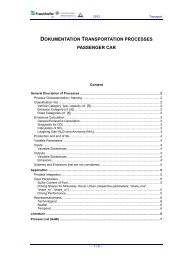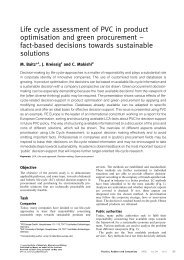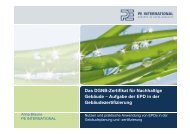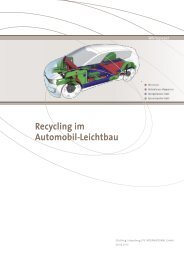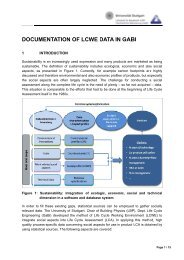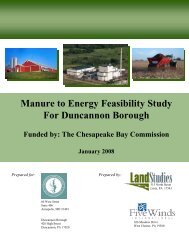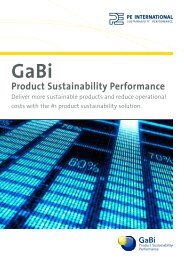GaBi Education - GaBi Software
GaBi Education - GaBi Software
GaBi Education - GaBi Software
You also want an ePaper? Increase the reach of your titles
YUMPU automatically turns print PDFs into web optimized ePapers that Google loves.
The acidification potential is given in<br />
sulphur dioxide equivalents (SO2-Eq.).<br />
The acidification potential is described<br />
as the ability of certain substances to<br />
build and release H + - ions. Certain<br />
emissions can also be considered to<br />
have an acidification potential, if the<br />
given S-, N- and halogen atoms are<br />
set in proportion to the molecular<br />
mass of the emission. The reference<br />
substance is sulphur dioxide.<br />
Appendix A<br />
Appendix A 5 Eutrophication Potential (EP)<br />
Figure A 2: Acidification Potential<br />
(ISO 14044:2006)<br />
Eutrophication is the enrichment of nutrients in a certain place. Eutrophication can be<br />
aquatic or terrestrial. Air pollutants, waste water and fertilization in agriculture all contribute<br />
to eutrophication.<br />
The result in water is an accelerated algae growth, which in turn, prevents sunlight from<br />
reaching the lower depths. This leads to a decrease in photosynthesis and less oxygen<br />
production. In addition, oxygen is needed for the decomposition of dead algae. Both effects<br />
cause a decreased oxygen concentration in the water, which can eventually lead to<br />
fish dying and to anaerobic decomposition (decomposition without the presence of oxygen).<br />
Hydrogen sulphide and methane are thereby produced. This can lead, among others,<br />
to the destruction of the eco-system.<br />
On eutrophicated soils, an increased susceptibility of plants to diseases and pests is often<br />
observed, as is a degradation of plant stability. If the nutrification level exceeds the<br />
amounts of nitrogen necessary for a maximum harvest, it can lead to an enrichment of<br />
nitrate. This can cause, by means of leaching, increased nitrate content in groundwater.<br />
Nitrate also ends up in drinking water.<br />
Nitrate at low levels is harmless from a<br />
toxicological point of view. However,<br />
nitrite, a reaction product of nitrate, is<br />
toxic to humans. The causes of eutrophication<br />
are displayed in Figure A 3.<br />
The eutrophication potential is calculated<br />
in phosphate equivalents<br />
(PO4-Eq). As with acidification potential,<br />
it‟s important to remember that the<br />
effects of eutrophication potential differ<br />
regionally.<br />
NOX NOX<br />
Figure A 3: Eutrophication Potential<br />
(ISO 14044:2006)<br />
62<br />
H 2SO 44<br />
Air pollution<br />
N2O<br />
HNO 3<br />
NH3 NH3<br />
Waste water<br />
-3<br />
PO4 PO4<br />
SO 2<br />
NO X<br />
Fertilisation<br />
NO3 - NO3 -<br />
+<br />
NH4 NH4



